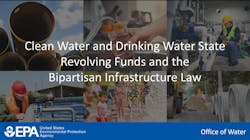Overview of the Bipartisan Infrastructure Law SRF Implementation
The U.S. EPA shared a memorandum March 9 regarding the implementation of $43.4 billion of the Bipartisan Infrastructure Law (BIL) funding through the Drinking Water State Revolving Fund (DWSRF) and Clean Water State Revolving Fund (CWSRF). These two programs account for the bulk of water and wastewater funding in the BIL, which was previously known as the Infrastructure Investment & Jobs Act when it was debated and passed in Congress.
Following the memorandum on March 9, EPA hosted a webinar March 10 to provide a high level overview on this funding. The following information is taken from that webinar. Please note that due to its high level nature, the information below does not go deeply into specific guidance, but rather shares the frameworks and outline to move forward with SRF funding from the BIL as soon as appropriations are finalized in Congress.
Editor's Note: This article is not exhaustive of the memo's information, and Water & Wastes Digest encourages industry professionals to read read the full memorandum from EPA Assistant Administrator for the Office of Water Radhika Fox. The full memo can be found here: https://www.epa.gov/system/files/documents/2022-03/combined_srf-implementation-memo_final_03.2022.pdf. Additionally, EPA has also released an interactive tool to break down funding allocations by state here: https://www.epa.gov/infrastructure/2022-clean-water-and-drinking-water-state-revolving-funds-srfs.
9 Key Priorities for Water in the BIL
- Provide flexibility to meet water needs at the local level.
- Increased investment in disadvantaged communities.
- Funding for lead service line replacement to rapidly address the issue of lead in water.
- Address PFAS and emerging contaminants.
- Improve sector resilience with a focus on One Water innovation.
- Renew the American water workforce.
- Cultivate domestic manufacturing.
- Fully enforce civil rights and equity for water programs.
- Refine the SRF process to build a deep project pipeline.
The 5 SRF Funding Buckets in the BIL
The SRF funding mechanisms within the BIL are split across five buckets: CWSRF General Supplemental, CWSRF Emerging Contaminants, DWSRF General Supplemental, DWSRF Emerging Contaminants, and DWSRF Lead Service Line Replacement. For each of the Emerging Contaminants buckets, PFAS projects are a large focus.
If a project's primary purpose is to address a contaminant that is addressed through National Primary Drinking Water Regulation, that project is not eligible to receive funding from the Emerging Contaminant bucket, unless it is addressing PFAS and promulgation on PFAS in the NPDWR has occured. Essentially, PFAS projects are an exception to the eligibility requirements for the Emerging Contaminants bucket of funding for CWSRF and DWSRF due to Congress' intentional language in the BIL to address that family of chemicals in water and wastewater.
Below follows a table with the listed funding for each bucket year-over-year as well as its 5-year total. This funding is in addition to the ongoing CWSRF and DWSRF appropriations not related to the BIL. Allocations by state can be found in the EPA BIL Interactive Tool.
Defining Emerging Contaminants
The definition of an Emerging Contaminant that makes a project eligible for funding in the CWSRF and DWSRF Emerging Contaminants funding buckets mentioned above is defined within the memo released March 9.
CWSRF Emerging Contaminants Definition
The EPA SRF Implementation Memo definition for CWSRF Emerging Contaminants is as follows:
Emerging contaminants refer to substances and microorganisms, including manufactured or naturally occurring physical, chemical, biological, radiological, or nuclear materials, which are known or anticipated in the environment, that may pose newly identified or re-emerging risks to human health, aquatic life, or the environment.26 These substances, microorganisms or materials can include many different types of natural or manufactured chemicals and substances – such as those in some compounds of personal care products, pharmaceuticals, industrial chemicals, pesticides, and microplastics.
Noted in Appendix B of the memo are the following five areas of emerging contaminants that fulfill eligibility requirements for this particular area of BIL Funding. Further details on the specific definitions of these areas can be found on page 36 and page 37 in Appendix B of the memo.
- Perfluoroalkyl and polyfluoroalkyl substances (PFAS) and other persistent organic pollutants (POPs).
- Biological contaminants and microorganisms
- Some compounds of pharmaceuticals and personal care products (PPCPs)
- Nanomaterials
- Microplastics/Nanoplastics
DWSRF Emerging Contaminants Definition
Verbatim from the EPA SRF Implementation Memo, the following defines an Emerging Contaminant for the purpose of the DWSRF Emerging Contaminants funding bucket noted earlier in this article:
For a project or activity to be eligible for funding under this appropriation, it must be otherwise DWSRF eligible and the primary purpose must be to address emerging contaminants in drinking water. Given the clear Congressional intent that these funds focus on projects addressing perfluoroalkyl and polyfluoroalkyl substances (hereinafter PFAS), EPA expects states to actively solicit and prioritize PFAS-focused projects. States, however, have the flexibility to fund projects for any contaminant in any of EPA’s Contaminant Candidate Lists. For example, EPA also encourages states to consider using these funds to address perchlorate as well as contaminants that have higher levels of occurrence or health concerns.
As noted previously as well, if a projects primary purpose is to address a contaminant promulgated in the NPDWR, that project is not eligible for this funding. The memo uses projects to address arsenic or nitrate as an example of an ineligible project for this bucket of funding. However, EPA also notes its intention to promulgate PFAS regulations in the NPDWR and that these particular regulations will be an exception to this rule.
"Given stated Congressional intent of this appropriation, PFAS-focused projects will be eligible for funding under this appropriation regardless of whether EPA has established a NPDWR for that particular PFAS or group of PFAS. More information on PFAS is located here: https://www.epa.gov/pfas," the memo states.
Defining Disadvantaged Community
The definition of a disadvantaged community as it relates to the BIL funding for water and wastewater will be determined by the individual states. EPA has not provided this definition, and instead has provided encouragement for states to conduct active outreach in communities throughout their state and to use tools such as median household income or other metrics to set this definition. Below follows verbatim language in the memo on page 40 in Appendix E regarding this particular aspect of the BIL SRF implementation:
There is significant variation across the country in the amount of assistance directed to disadvantaged communities and the characteristics of communities that qualify for this assistance. The CWA and the SDWA both state that the Administrator may publish information to assist states in establishing affordability criteria. The information in this memo is one step in an ongoing EPA effort to analyze criteria and adjust them as needed to ensure that the definitions used are compliant with the CWA and SDWA as well as meet the community affordability needs within states. Some key considerations are described below for evaluating how different affordability criteria can capture communities in need. EPA will work with states to strengthen their criteria for distributing additional subsidization. EPA may also provide additional information identified as part of Justice 40. Any criteria or thresholds should be modified by SRF programs to reflect state conditions and considerations.
While EPA did not define this particular term, it did share informationon "disadvantaged community definitions that can be barriers." Water & Wastes Digest has formatted these bullets into declarative statements that should be followed so as to have the best chance at complying with EPA's intention for state definitions of a disadvantaged community.
- Do not solely use the term "unaffordable" as some state rate considerations can be a barrier to systems with low capacity and/or poor rate structures.
- Do not use a low cap on additional subsidy as this could create a barrier for communities that need more subsidation to take on a loan. EPA lists 30% additional subsidy as an example in this bullet point.
- Do not solely use population or use population as a determining factor.
Build America, Buy America Rules
During the webinar March 10, attendees asked about an update on the Buy America and Buy American Rules provided in the BIL, and what that will look like for the water industry. EPA officials said they have held meetings with stakeholders, the Made in America Office and with the Office of Management & Budget (OMB) and that EPA is "awaiting further guidance from OMB."
Updated April 25, 2022: This has now been updated to reflect the Build America, Buy America law. The U.S. EPA held a webinar on Build America, Buy America (BABA) on April 25 for the law, which goes into effect May 14. Read a breakdown of that EPA webinar here: https://www.wwdmag.com/regulations/what-build-america-buy-america-baba for more details.
Conclusion
There is a lot more to unpack from the EPA BIL SRF Implementation Memorandum as this only touches on very high level elements mentioned in the memo. Water & Wastes Digest encourages all industry professionals seeking to use BIL SRF funding to read the memo in full to have a complete picture of EPA's intention when it comes to the implementation provisions of this funding.
About the Author
Bob Crossen
Bob Crossen is the editorial director for the Endeavor Business Media Water Group, which publishes WaterWorld, Wastewater Digest and Stormwater Solutions. Crossen graduated from Illinois State University in Dec. 2011 with a Bachelor of Arts in German and a Bachelor of Arts in Journalism. He worked for Campbell Publications, a weekly newspaper company in rural Illinois outside St. Louis for four years as a reporter and regional editor.

